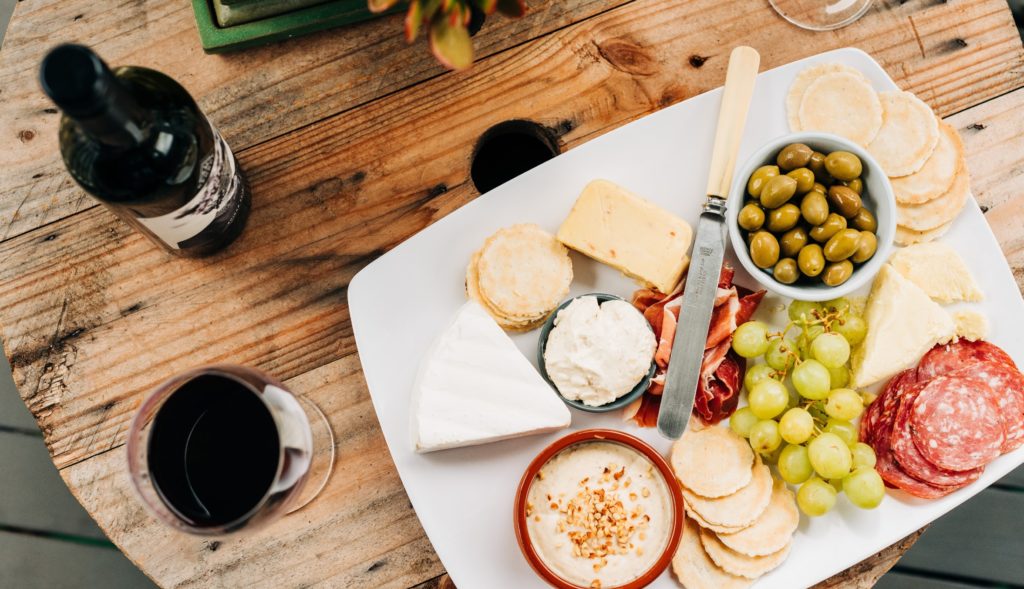Pairing wine with cheese is a tradition that has existed for hundreds of years in many different cultures. It is reported that early British wine merchants were among the first to combine these two foods and drinks together.
Wine and cheese are typically linked together because they both tend to taste like the region they’re from, and the fattiness of cheese perfectly offsets the sharpness of wine. For this reason, it is very easy to find flavors in wine and cheese that complement each other. For instance, cheese from France like Le Cacouyard pairs well with a wine from France like Baron De Seillac.
It’s always nice having something to munch on when you’re sipping. This combination can be served after meals as a dessert or as a snack itself. It’s a very versatile pairing, and it works perfectly in casual and formal settings.
It’s best to indulge in wine and cheese with friends and family. You’ve likely seen this combo at one of your family gatherings or your local bar. Who doesn’t like some good ol’ cheese and crackers? Throw in a bottle of wine to the mix, and you’ve got yourself quite the kickback.
As the wine industry grows and expands, the cheese industry has always been incredibly diverse and expansive. There are many different types of cheeses, just as there are countless numbers of wines. Fortunately, many of the world’s award-winning cheeses are easy to find in your local supermarket.
When looking for pairing options, it can be difficult to find a place to start. Keep reading below with Saucey to learn how to pair wine and cheese like a pro.
Tannins and how they impact the wine pairing process
To truly understand what goes into a wine and cheese pairing, it’s important to be informed about the different elements of wine. Besides the actual taste, there are other aspects of your wine that you must consider when choosing a cheese to accompany it.
One of these factors is the tannins, yellow, brownish organic substances present in galls, bark, and plant tissue. Tannings are abundant in the skin of grapes and can affect the taste and texture of your wine.
When you drink wine, it usually leaves you with a puckering, moist aftertaste. That feeling comes from the tannins in the wine. Within the wine, tannins interact positively with proteins to create a rich, savory taste.
Red wines contain the highest concentration of tannins, as they are fermented with grape skins. White wines, on the other hand, have the skins removed before the fermentation process. However, they still receive some tannins from being aged in oak barrels.
Tannins also contribute to the aging process. Over time, these molecules break down and add to the body of the wine. This substance even has been suggested to prevent heart disease.
The tannins in your wine should add to the flavor of your cheese. If you’re going for a flavorful pairing, look for a wine high in tannins like Nebbiolo Barbera and match it with a cheese dense in flavors, like goat cheese or feta. Look for a low-tannin wine like Merlot for a milder pairing and match it with something nutty like Parmesan.

Sufficient acidity matters for cheese pairings
The next thing you should look for in your wine is its acidity. All wines contain some level of malic acid from the grape’s pulp. When this acid hits your tongue, it leaves a bit of a lingering tanginess, which is what gives you that sharp flavor that’s so often associated with white wines. A wine that lacks acidity might end up tasting flat and watery.
Acidic wines are designed to make your mouth water. They help balance out the dryness that is produced from the tannins in it. Together, these two elements create a balanced, smooth texture.
Cheap, lower-quality wines will typically lack acidity or contain additives that mimic true acidity. When it comes to cheese, wines with medium to high acidity are generally ideal. You want some level of acidity in your drink to cut through the richness of the cheese.
The sweetness test
Now obviously, the taste of your wine plays a huge role in what cheese it should be paired with. Following that, the sweetness of your wine is another one of the most important elements for cheese pairings.
Usually, the grapes are used to make the wine sweet are harvested late. The longer the grapes stay on the vine, the sweeter they’ll be. For exceptionally sweet dessert wines, their grapes are often picked when they’re shriveling and overly ripe.
To test the sweetness of your wine, first put your nose up to the glass. Take a whiff as you swirl the glass gently. Then, take a small sip. A sweet wine will register first at the tip of your tongue; this is where the receptors for sweetness are located. Another sweetness measure you can take is licking your cheek after you’ve taken a sip. If it’s dry, then your wine probably isn’t a sweet wine.
Sweet and salty foods are known to work well together, so a sweet wine pairs perfectly with a strong, stinky cheese like blue cheese or Camembert.
Light, medium, and full-bodied wine
Wines can be light-bodied, medium-bodied, or full-bodied. This term refers to the weight and thickness of your wine and the way it feels in your mouth. This example is a bit strange, but if we were to use this word to describe milk, we would call whole milk full-bodied and fat-free milk light-bodied.
The body of your wine affects how quickly it washes over your tongue. Wines with a fuller body will typically have a longer, more lasting aftertaste. On the contrary, light-bodied wines will have a smoother, shorter aftertaste.
This isn’t a hard and fast rule, but full-bodied wines tend to go really well with hard cheeses like cheddar and Manchego.
The different cheeses
Now, it’s time to talk about the different types of cheeses. With so many different styles of this food available, it can be overwhelming to decide what’s best for you. But it can also be super fun.
For hard cheeses like cheddar, Comté, Parmigiano Reggiano, and Manchego, a medium-bodied red wine like Cabernet Sauvignon is excellent to pair with. Hard cheeses are usually the easiest type of cheese to pair wine with since they provide a stable assortment of flavors and textures.
Next, we have soft cheeses like Brie and Camembert and spreadable cheeses like cream cheese and Port Wine Cheddar. These cheeses are paired best with fruity red wines like Beaujolais. Rosé is also a solid choice.
Then, there are blue cheeses. This category includes Stilton, Roquefort, and gorgonzola. For the pungent, crumbly taste of blue cheese, sweet wines are the go-to. One of our favorites is Sherry.
There are many other niche styles of cheese, but these are some of the basics. As you become more and more familiar with wine and cheese pairings, you’ll likely want to expand your range of both, so keep an eye out for new and interesting flavor profiles.
Wine and cheese are the ultimate pairings
Whether it’s a party, a family gathering, or just a night in with friends, there’s no wrong time to enjoy some wine and cheese.
The key to a perfect pairing is matching the intensity of the cheese with the intensity of the wine. When in doubt, this mantra is a safe statement to lean back on.
Don’t be afraid to step out of the box with your choices. Be adventurous with your pairings, and most importantly, have fun. And for all your wine needs, Saucey has your back.



